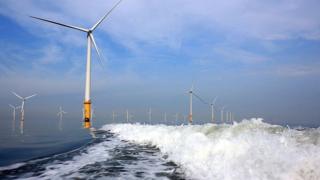UK wind power capacity to nearly double by 2030, industry says

Image copyright
Getty Images
The UK’s offshore wind power capacity is set to nearly double over the next decade, as a result of a new government initiative, according to the industry.
It said that by 2030, between a fifth and a third of the UK’s electricity could come from offshore wind power.
Thanks to plummeting costs, offshore wind has become an increasingly affordable source of clean energy.
The UK has cut costs for consumers with a system which forces firms to bid for financial support in auctions.
The Climate and Energy Secretary, Claire Perry, confirmed on Monday that these auctions would be held every two years to give the industry the stability it needed to continue to build the huge structures that tower over the waves.
At the auctions, energy firms bid for contracts that guarantee a minimum price for the power they will sell.
The auction process has forced firms to be transparent about the amount of support they actually need, and has halved the cost of supporting offshore wind.
The system has been adopted worldwide and is recognised as a major UK contribution to the development of clean energy.
RenewableUK’s chief executive, Hugh McNeal, said: “This sets us on the path to deliver the tens of billions of pounds of investment that will be needed to meet our ambition of at least 30GW by 2030.
“We can look forward to a pipeline of new offshore wind projects that will support tens of thousands of jobs across the UK.”
- SSE profits hit as hot weather affects wind turbines
- Reaping the wind with the biggest turbines ever made
- Offshore wind power cheaper than new nuclear
‘Confusing and irrational’
The initiative was generally welcomed by environmental groups, but they said the ascent of offshore wind called into question the government’s continuing support for nuclear power, which will be much more expensive.
Kate Blagojevic from Greenpeace said: “Onshore wind is also getting cheaper all the time, and is now the UK’s cheapest electricity source.
“Solar has been dropping for so long that it has actually reduced in cost by an astonishing 99% since the technology was commercialised.
“This makes the government’s huge financial support for nuclear, the one low carbon source which keeps going up and up in price, all the more confusing and irrational.”
The government insists it needs a diversity of power supply.
Follow Roger on Twitter @rharrabin

